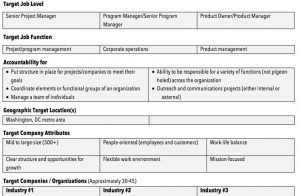When Arleta Brodell, 28, decided she was ready to find a new job, she knew her search would take time but she didn’t expect it to take 14 months.
Ten months into her search, Brodell hired a job coach who told her to stop applying for jobs online. “My approach had been to apply for a job and then figure out if it was something I wanted to do,” Brodell says. “That meant I wasn’t getting job offers that were interesting.”
 Brodell shifted her focus from apply for jobs to developing a targeted list of companies she wanted to work for and setting up in-person meetings with people who work at those companies. Four months later, Brodell landed a job at her dream company, earning 75 percent more than her previous salary.
Brodell shifted her focus from apply for jobs to developing a targeted list of companies she wanted to work for and setting up in-person meetings with people who work at those companies. Four months later, Brodell landed a job at her dream company, earning 75 percent more than her previous salary.
“I received my best results when I stopped applying for jobs online,” Brodell says. Here’s how Brodell tapped into the hidden job market.
Develop a plan
Rather than apply for any job that remotely matched her current job title or qualifications, Brodell spent time creating a plan that outlined what her ideal job would look like including ideal title, duties and company culture. “Be honest about what you don’t want to do, what you want to do and what is most energizing,” she says. Using LinkedIn, she developed a list of 30 companies that met her criteria. The spreadsheet below illustrates how Brodell developed her plan.
Ask for an introduction
She sent her list of targeted companies to friends, colleagues and family members, and asked if they knew anyone working at any of those companies. If they did, she asked for an introduction. Many of those introductions led to in-person meetings and phone calls.
Use LinkedIn strategically
Instead of using LinkedIn to search for jobs openings, Brodell used it to find people working at the companies she wanted to interview at. Then she would connect with them through LinkedIn and ask if they would meet with her in person or talk with her on the phone. “If a job came up at their company that I was interested in, I would go directly to them,” she says, and ask for a referral rather than apply through the usual channels. This approach can be a game changer. Referred applicants are five times more likely than average to be hired, and 15 times more likely to be hired than an applicant from a job board, according to a 2017 study by Jobvite.
Prioritize your contacts
After a 10-month job search, Brodell found she had an unwieldy spreadsheet of 30-plus names, emails and phone numbers. To make it easier to keep up with her contacts, Brodell categorized them into three groups—active job lead (contact regularly), possible job lead (check in with occasionally) and no active job lead (keep in touch through LinkedIn).
Participate in networking events
Brodell joined several professional organizations, including one that offers a monthly “meet the company” event where current employees speak on a panel about what it’s like to work at that company. Brodell attended a meeting that featured the company she wanted to work for the most. After the presentation, she introduced herself to one of the managers who spoke on the panel and she asked the manager for a coffee meeting. Over coffee the following week, the manager told Brodell about an opening on her team and invited Brodell to apply. Brodell didn’t get that job but the manager was so impressed she recommended Brodell for another job at the company, which Brodell was ultimately hired for.
“Developing a plan helped me get to the point where I could articular what I wanted to do,” Brodell says, “and that put me in a position where jobs would open up for me.”
Reprinted from: Forbes – https://www.forbes.com – 5.15.17

Sorry, the comment form is closed at this time.